2005 RENAULT MEGANE transmission
[x] Cancel search: transmissionPage 135 of 250

Downloaded from www.Manualslib.com manuals search engine
NU761_2_G2-FRA.qxd 4/11/05 10:48 Page 2.35
AUTOMATIC TRANSMISSION (continued)Driving in manual mode
With the selector lever in position D,
move the lever to the left.
Pushing the lever repeatedly allows
you to change gears manually.
- to move down through the gears, push the lever backwards.
- to move up through the gears, push the lever forwards.
The gear selected is displayed on the
instrument panel. Special cases
Under certain driving conditions
(e.g.: engine protection, with
electronic stability program (ESP)
operational: etc.) the “automatic
system” may change gear
automatically.
Likewise, to prevent “incorrect
manoeuvres”, a gear change may be
refused by the “automatic system”:
in this case the gear display flashes
for a few seconds as a warning.
How to drive as economically as
possible
Leave the selector in position
Don
the open road, depress the
accelerator pedal slightly to ensure
automatic gear changes at
comparatively low engine speeds.
Accelerating and overtaking
Depress the accelerator pedal
briskly and fully (so that it goes
beyond the kickdown point).
This will enable you to change
down to the optimal gear within the
engine range.
2.35
NU761_2_G2-ENG.qxp 03-Jan-06 20:48 Page 2.35 (Black/Process Black\
plate)
Page 136 of 250
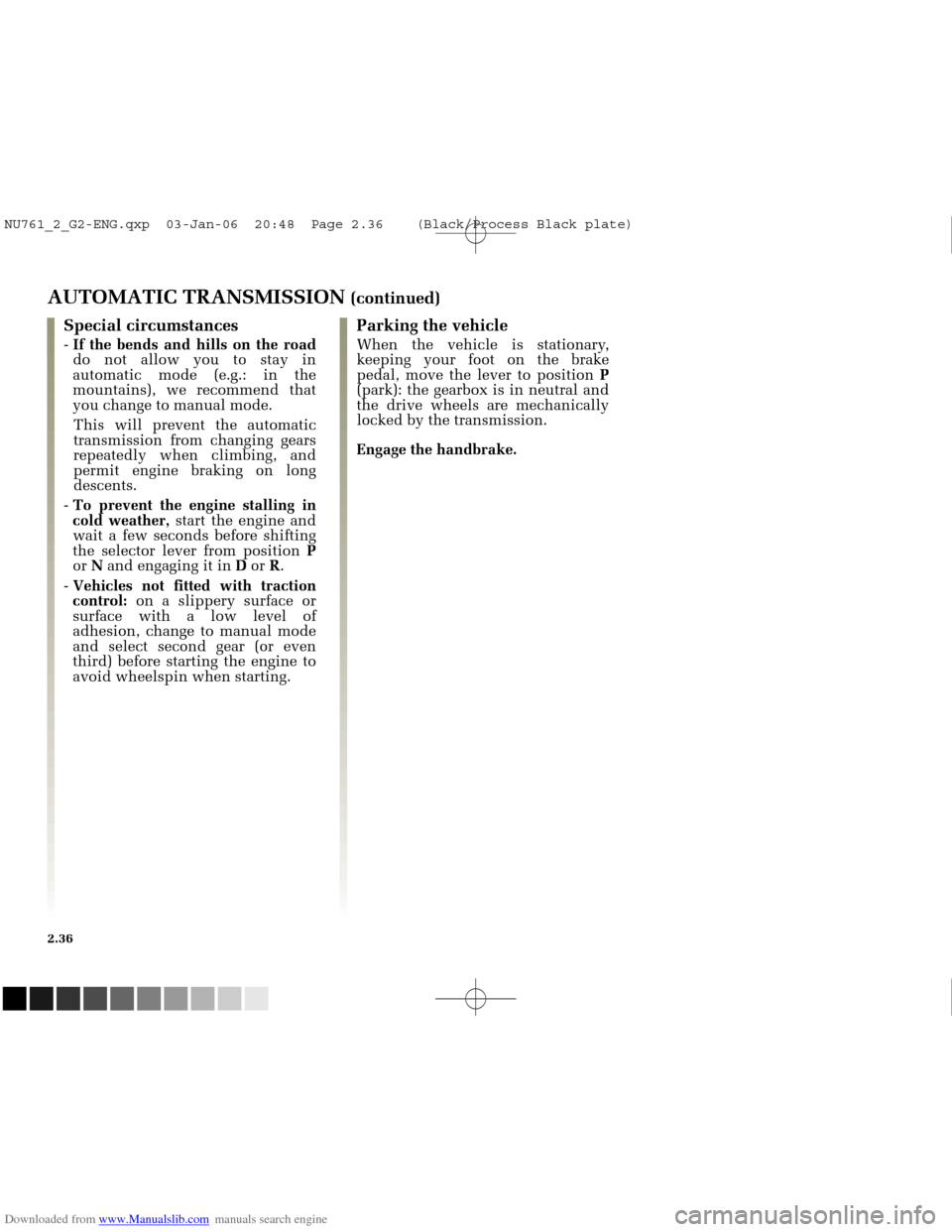
Downloaded from www.Manualslib.com manuals search engine
NU761_2_G2-FRA.qxd 4/11/05 10:48 Page 2.36
2.36
AUTOMATIC TRANSMISSION (continued)Parking the vehicle
When the vehicle is stationary,
keeping your foot on the brake
pedal, move the lever to position P
(park): the gearbox is in neutral and
the drive wheels are mechanically
locked by the transmission.
Engage the handbrake.
Special circumstances
- If the bends and hills on the road
do not allow you to stay in
automatic mode (e.g.: in the
mountains), we recommend that
you change to manual mode.
This will prevent the automatic
transmission from changing gears
repeatedly when climbing, and
permit engine braking on long
descents.
- To prevent the engine stalling in
cold weather, start the engine and
wait a few seconds before shifting
the selector lever from position P
or Nand engaging it in Dor R.
- Vehicles not fitted with traction
control: on a slippery surface or
surface with a low level of
adhesion, change to manual mode
and select second gear (or even
third) before starting the engine to
avoid wheelspin when starting.
NU761_2_G2-ENG.qxp 03-Jan-06 20:48 Page 2.36 (Black/Process Black\
plate)
Page 137 of 250
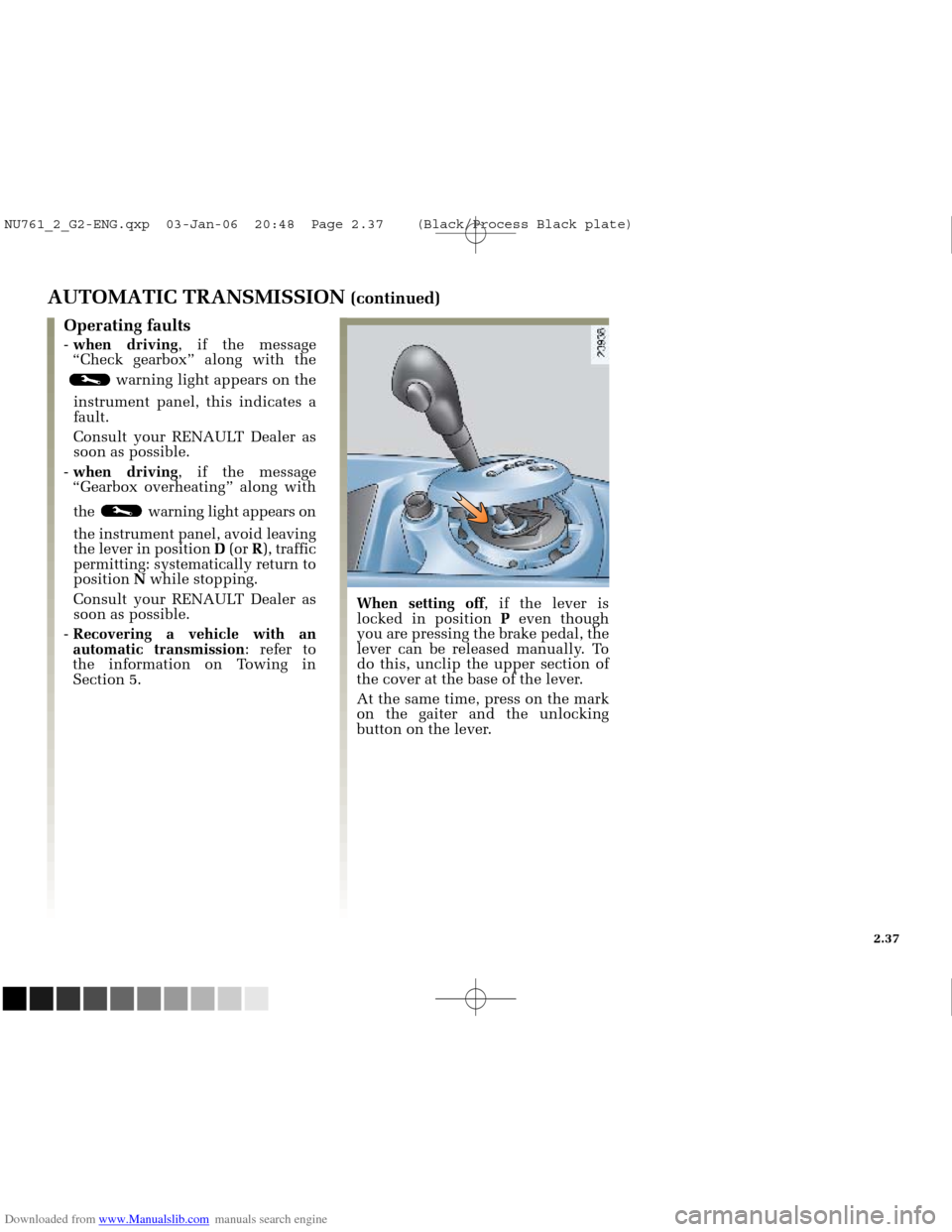
Downloaded from www.Manualslib.com manuals search engine
NU761_2_G2-FRA.qxd 4/11/05 10:49 Page 2.37
AUTOMATIC TRANSMISSION (continued)
Operating faults
- when driving , if the message
“Check gearbox” along with the
warning light appears on the
instrument panel, this indicates a
fault.
Consult your RENAULT Dealer as
soon as possible.
- when driving , if the message
“Gearbox overheating” along with
the warning light appears on
the instrument panel, avoid leaving
the lever in position D(or R), traffic
permitting: systematically return to
position Nwhile stopping.
Consult your RENAULT Dealer as
soon as possible.
- Recovering a vehicle with an
automatic transmission : refer to
the information on Towing in
Section 5.
When setting off , if the lever is
locked in position Peven though
you are pressing the brake pedal, the
lever can be released manually. To
do this, unclip the upper section of
the cover at the base of the lever.
At the same time, press on the mark
on the gaiter and the unlocking
button on the lever.
2.37
NU761_2_G2-ENG.qxp 03-Jan-06 20:48 Page 2.37 (Black/Process Black\
plate)
Page 193 of 250
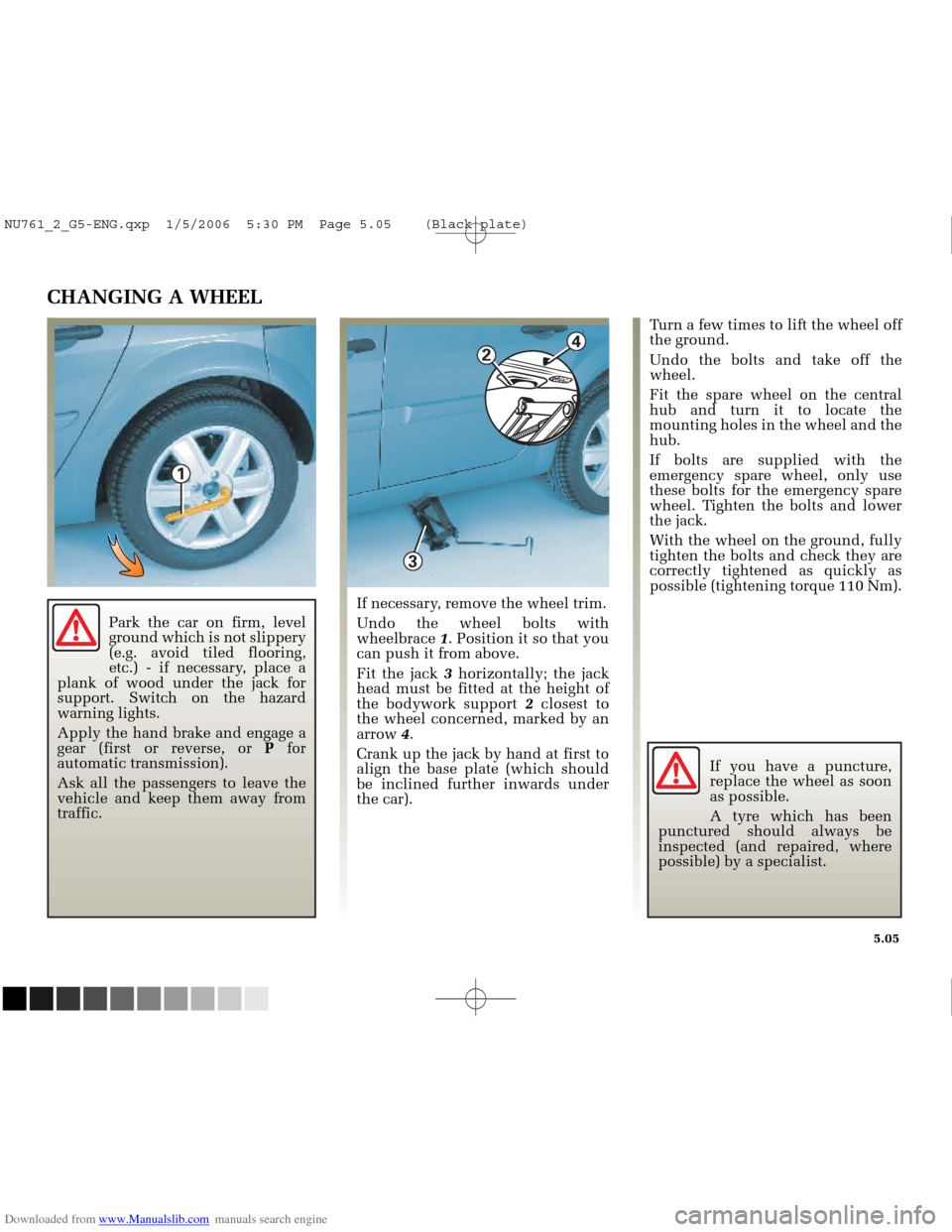
Downloaded from www.Manualslib.com manuals search engine
3
4
2
1
NU761_2_G5-FRA.qxd 4/11/05 11:09 Page 5.05
5.05
CHANGING A WHEEL
If necessary, remove the wheel trim.
Undo the wheel bolts with
wheelbrace 1. Position it so that you
can push it from above.
Fit the jack 3horizontally; the jack
head must be fitted at the height of
the bodywork support 2closest to
the wheel concerned, marked by an
arrow 4.
Crank up the jack by hand at first to
align the base plate (which should
be inclined further inwards under
the car). Turn a few times to lift the wheel off
the ground.
Undo the bolts and take off the
wheel.
Fit the spare wheel on the central
hub and turn it to locate the
mounting holes in the wheel and the
hub.
If bolts are supplied with the
emergency spare wheel, only use
these bolts for the emergency spare
wheel. Tighten the bolts and lower
the jack.
With the wheel on the ground, fully
tighten the bolts and check they are
correctly tightened as quickly as
possible (tightening torque 110 Nm).
If you have a puncture,
replace the wheel as soon
as possible.
A tyre which has been
punctured should always be
inspected (and repaired, where
possible) by a specialist.
Park the car on firm, level
ground which is not slippery
(e.g. avoid tiled flooring,
etc.) - if necessary, place a
plank of wood under the jack for
support. Switch on the hazard
warning lights.
Apply the hand brake and engage a
gear (first or reverse, or Pfor
automatic transmission).
Ask all the passengers to leave the
vehicle and keep them away from
traffic.
NU761_2_G5-ENG.qxp 1/5/2006 5:30 PM Page 5.05 (Black plate)
Page 216 of 250
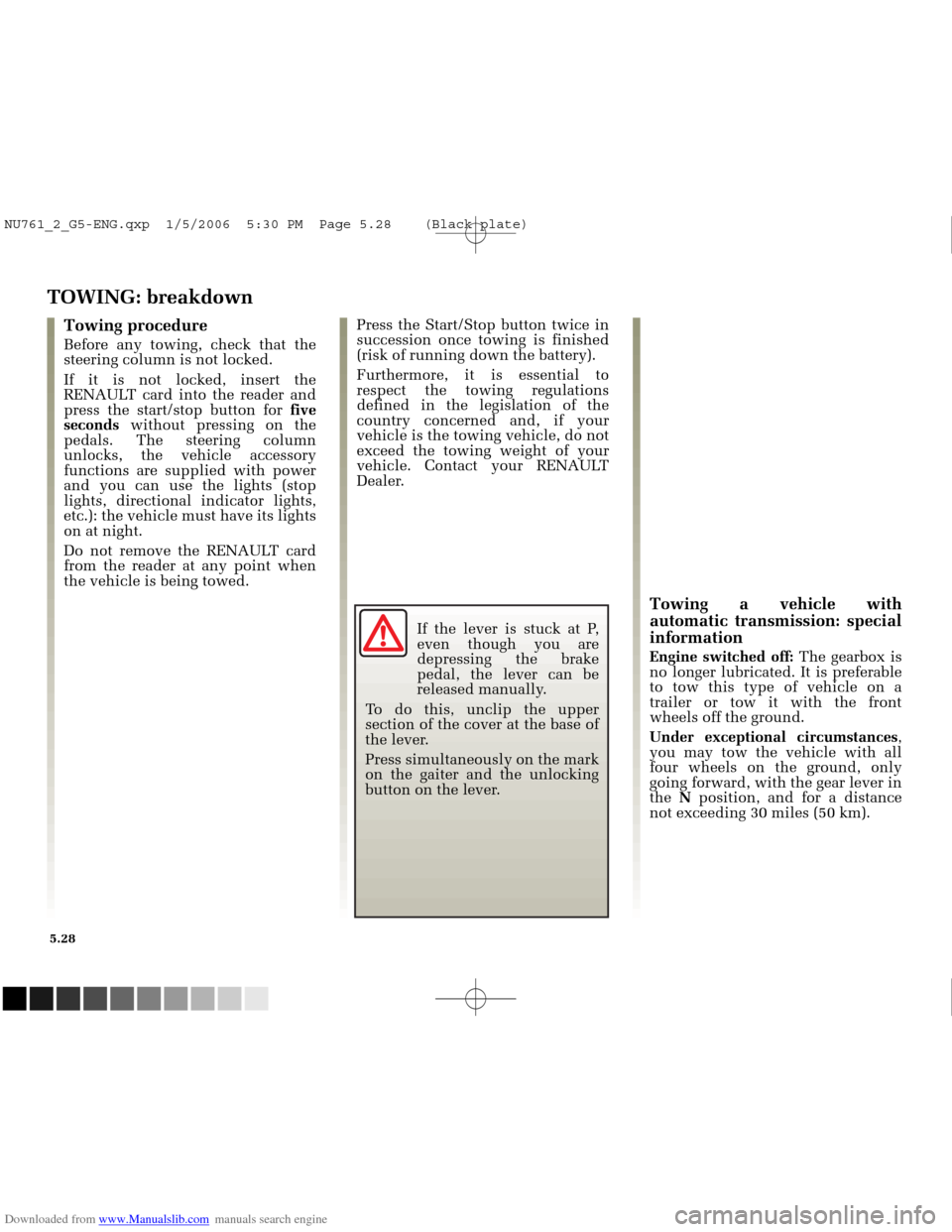
Downloaded from www.Manualslib.com manuals search engine
NU761_2_G5-FRA.qxd 4/11/05 11:10 Page 5.28
5.28
TOWING: breakdown
Press the Start/Stop button twice in
succession once towing is finished
(risk of running down the battery).
Furthermore, it is essential to
respect the towing regulations
defined in the legislation of the
country concerned and, if your
vehicle is the towing vehicle, do not
exceed the towing weight of your
vehicle. Contact your RENAULT
Dealer.Towing procedure
Before any towing, check that the
steering column is not locked.
If it is not locked, insert the
RENAULT card into the reader and
press the start/stop button for five
seconds without pressing on the
pedals. The steering column
unlocks, the vehicle accessory
functions are supplied with power
and you can use the lights (stop
lights, directional indicator lights,
etc.): the vehicle must have its lights
on at night.
Do not remove the RENAULT card
from the reader at any point when
the vehicle is being towed.
Towing a vehicle with
automatic transmission: special
information
Engine switched off: The gearbox is
no longer lubricated. It is preferable
to tow this type of vehicle on a
trailer or tow it with the front
wheels off the ground.
Under exceptional circumstances ,
you may tow the vehicle with all
four wheels on the ground, only
going forward, with the gear lever in
the N position, and for a distance
not exceeding 30 miles (50 km).
If the lever is stuck at P,
even though you are
depressing the brake
pedal, the lever can be
released manually.
To do this, unclip the upper
section of the cover at the base of
the lever.
Press simultaneously on the mark
on the gaiter and the unlocking
button on the lever.
NU761_2_G5-ENG.qxp 1/5/2006 5:30 PM Page 5.28 (Black plate)
Page 246 of 250
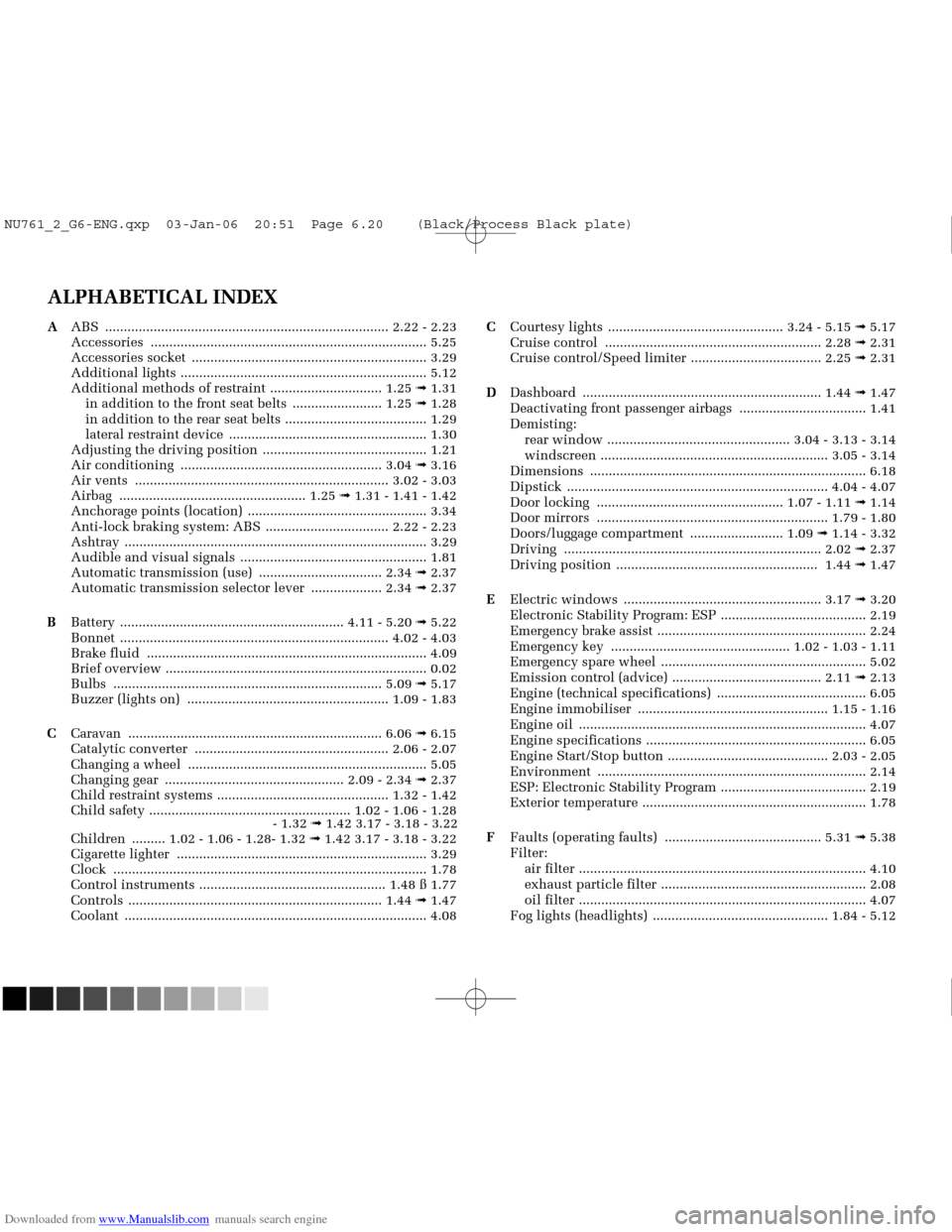
Downloaded from www.Manualslib.com manuals search engine
NU761_2_G6-FRA.qxd 4/11/05 11:11 Page 6.20
ALPHABETICAL INDEX
AABS ........................................................................\
.... 2.22 - 2.23
Accessories ............................................................\
.............. 5.25
Accessories socket ............................................................... 3.29
Additional lights .................................................................. 5.12
Additional methods of restraint .............................. 1.25 ➟ 1.31
in addition to the front seat belts ........................ 1.25 ➟ 1.28
in addition to the rear seat belts ...................................... 1.29
lateral restraint device ..................................................... 1.30
Adjusting the driving position ............................................ 1.21
Air conditioning ...................................................... 3.04 ➟ 3.16
Air vents .................................................................... 3.02 - 3.03
Airbag .................................................. 1.25 ➟ 1.31 - 1.41 - 1.42
Anchorage points (location) ................................................ 3.34
Anti-lock braking system: ABS ................................. 2.22 - 2.23
Ashtray ................................................................\
................. 3.29
Audible and visual signals .................................................. 1.81
Automatic transmission (use) ................................. 2.34 ➟ 2.37
Automatic transmission selector lever ................... 2.34 ➟ 2.37
B Battery ............................................................ 4.11 - 5.20 ➟ 5.22
Bonnet ........................................................................\
4.02 - 4.03
Brake fluid ........................................................................\
... 4.09
Brief overview ...................................................................... 0.02
Bulbs ..................................................................\
...... 5.09 ➟ 5.17
Buzzer (lights on) ...................................................... 1.09 - 1.83
C Caravan ................................................................\
.... 6.06 ➟ 6.15
Catalytic converter .................................................... 2.06 - 2.07
Changing a wheel ................................................................ 5.05
Changing gear ................................................ 2.09 - 2.34 ➟ 2.37
Child restraint systems .............................................. 1.32 - 1.42
Child safety ...................................................... 1.02 - 1.06 - 1.28 - 1.32➟ 1.42 3.17 - 3.18 - 3.22
Children ......... 1.02 - 1.06 - 1.28- 1.32 ➟ 1.42 3.17 - 3.18 - 3.22
Cigarette lighter ................................................................... 3.29
Clock ..................................................................\
.................. 1.78
Control instruments .................................................. 1.48 ß 1.77
Controls ...............................................................\
..... 1.44 ➟ 1.47
Coolant ................................................................\
................. 4.08 C
Courtesy lights ............................................... 3.24 - 5.15 ➟ 5.17
Cruise control .......................................................... 2.28 ➟ 2.31
Cruise control/Speed limiter ................................... 2.25 ➟ 2.31
D Dashboard ..............................................................\
.. 1.44 ➟ 1.47
Deactivating front passenger airbags .................................. 1.41
Demisting: rear window ................................................. 3.04 - 3.13 - 3.14
windscreen ............................................................. 3.05 - 3.14
Dimensions .............................................................\
............. 6.18
Dipstick ...................................................................... 4.04 - 4.07
Door locking .................................................. 1.07 - 1.11 ➟ 1.14
Door mirrors .............................................................. 1.79 - 1.80
Doors/luggage compartment ......................... 1.09 ➟ 1.14 - 3.32
Driving ................................................................\
..... 2.02 ➟ 2.37
Driving position ...................................................... 1.44 ➟ 1.47
E Electric windows ..................................................... 3.17 ➟ 3.20
Electronic Stability Program: ESP ....................................... 2.19
Emergency brake assist ........................................................ 2.24
Emergency key ................................................ 1.02 - 1.03 - 1.11
Emergency spare wheel ....................................................... 5.02
Emission control (advice) ........................................ 2.11 ➟ 2.13
Engine (technical specifications) ........................................ 6.05
Engine immobiliser ................................................... 1.15 - 1.16
Engine oil ........................................................................\
..... 4.07
Engine specifications ........................................................... 6.05
Engine Start/Stop button ........................................... 2.03 - 2.05
Environment ............................................................\
............ 2.14
ESP: Electronic Stability Program ....................................... 2.19
Exterior temperature ............................................................ 1.78
F Faults (operating faults) .......................................... 5.31 ➟ 5.38
Filter: air filter ........................................................................\
..... 4.10
exhaust particle filter ....................................................... 2.08
oil filter ........................................................................\
..... 4.07
Fog lights (headlights) ............................................... 1.84 - 5.12
NU761_2_G6-ENG.qxp 03-Jan-06 20:51 Page 6.20 (Black/Process Black\
plate)
Page 249 of 250

Downloaded from www.Manualslib.com manuals search engine
NU761_2_Gcv-FRA.qxd 4/11/05 11:12 Page 3
BC84 - NU761-2C:\Documentum\Checkout\NU761_2_Tcv-ENG.win 7/12/2005 9:13- page 2
has chosen ELF
Engines of all types
except 1. 9 dCi wi th
particle filter
1.9 dCi engines
with particle filter
Petrol and LPG engines
except 2.0T 16V
Renault Sport
Engine all types except
2.0T 16V Renault Sport
and 1.9 dCi with a par-
ticle filter
Gearbox
ELF EXCELLIUM LDX 5W-40ACEA A3 / B4Optimum performance and maximum protection in the most severe conditions
All types of driving
ELF EVOLUTION SXR 5W-40ACEA A3 / B4
Optimum performance
All types of driving
ELF SOLARIS RNX 5W-30ACEA C3
Optimum performance, par ticle filter protection and respect for the environment
All types of driving
ELF EVOLUTION SXR 5W-30ACEA A5 / B5
Fuel economy, engine protection and respect for the environment.
All types of driving
ELF COMPETITION ST 10W-40
ELF TURBO DIESEL 10W-40ACEA A3 / B4
ACEA B3 / B4
Other RENAULT approved lubricants for normal use.
Elf has developed specific lubricants for each Renault transmission:Tranself TRJ 75W80, Tranself TRT 75W80, Tranself TRP 75W80, Tranself TRX 75W80 for manual
gearboxes, Renaultmatic D3Syn and Renaultmatic D2 for automatic transmissions.These fluids are actively involved in the operation of your vehicle. (*)
RENAULT recommends using approved ELF products when topping up or changing the oil.
(*) Refer to your vehicle's Warranty and Services booklet for information regarding which grade of oil to use.
Consult your RENAULT Dealer or visit www.lubricants.elf.com